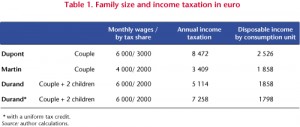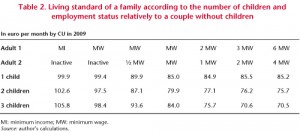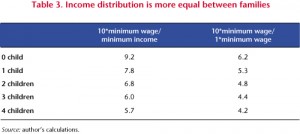Increased longevity and social security reform: questioning the optimality of individual accounts when education matters
par Gilles Le Garrec
In 1950, life expectancy at birth in Western Europe was 68 years. It is now 80 years and should reach 85 by 2050. The downside of this trend is the serious threat that is hanging over the financing of our public retirement systems. Financed on a pay-as-you-go (PAYG) basis, i.e. pension benefits are paid through contributions of contemporary workers, the systems must cope with an increasingly large number of pensioners compared to the number of contributors. For example, leaving the average age of retirement unchanged in France would lead to a ratio of pensioners to workers (the dependency ratio) of 70.1% in 2040, whereas this ratio was 35.8% in 1990. Changes are unavoidable. Maintaining the current level of benefits within the same system in the near future requires to increase either the contribution rate or the length of contribution (by delaying the age of retirement).
This financing problem calls into question the role of PAYG retirement systems in our societies. For instance, by evaluating the real pre-tax return on non-financial corporate capital at 9.3% and the growth rate over the same period (1960 to 1995) at 2.6%, Feldstein[1] unequivocally advocates the privatization of retirement systems and a switch to fully funded systems. He assesses the potential present-value gain at nearly $20 trillion for the United States. However, beside the change in the nature of the risk,[2] replacing conventional PAYG systems by financial – or funded – defined contribution (FDC) systems would certainly involve prohibitive social and political costs because one generation will have to pay twice. Implementing such a reform in Western democracies thus appears difficult. For that reason, in recent years a large focus has been put on non-financial – or notional – defined contribution (NDC) systems as legislated in Sweden in 1994. NDC systems are PAYG systems that mimic FDC systems. Individual contributions are noted on individual accounts. Accounts are credited with a rate of return that reflects demographic and productivity changes. Obviously, replacing conventional PAYG systems by NDC systems does not address the main concern of Feldstein, that is, the low return associated with the PAYG financing method. However, supporters of NDC systems claim that conventional systems, by linking pension benefits only partially to contributions, distort individual behaviours, inducing reduced work efforts or earlier retirements. In addition, they claim that only an explicit defined contribution system will be able to stabilize contributions in spite of aging populations.
Looking at the empirical facts, the supposed inefficiency of conventional retirement systems must be reconsidered. Firstly, even if their pension benefits are linked to partial earnings history, most conventional systems are close to actuarial fairness[3] as NDC systems because high-income earners live longer and have steeper age-earnings profiles. Secondly, stabilizing contributions can be achieved similarly within the scope of more conventional defined benefit systems, as seen in the “point system” in France or in Germany. In that case, the unit of pension rights is earnings points (not euros) and can be adjusted according to demographic and productivity changes, as in an NDC system. Cleverly designed conventional retirement systems can often do the same job as NDC systems. Finally, empirical findings from Sala-i-Martin[4] and Zhang and Zhang[5] tend to support a positive impact of retirement systems on economic growth through the human capital channel.
To explain the positive link between PAYG retirement systems and economic growth that is suggested by the empirical findings, previous authors have then focused on the human capital channel, and more particularly on parental altruism. In this strand of the literature, PAYG retirement systems result in higher economic growth because they provide an incentive for altruistic parents to invest more in their children’s education, even if investment per child remains insufficient to be socially optimal. In addition, they also provide an incentive for parents to have fewer children. In that context, when private behaviour is not observable, Cigno, Luporini and Pettini[6] show that a second-best policy would be to provide parents with subsidies linked to the number of children they have and their future capacity to pay taxes. To that end, Cigno[7] suggests that unconventional children-related pension systems be added to conventional retirement systems so as to allow individuals to earn a pension by raising children and by investing in their human capital. Introducing such an unconventional system could stimulate both fertility and economic growth. In France, the 10% bonus on pension benefits for parents of three children or more is such a pension-based fertility subsidy. However, for both reasons of economy and equity[8], these subsidies are taxed since the reform of 2013, with the risk of lowering the fertility incentives. This latter reform will imply more profound changes as from 2020 proportional subsidies will be replaced with payments only given to women on a per-child basis (the first child inclusive).
Beyond the impact of PAYG systems on parents’ behavior, results have first appeared mixed when considering people investment in their own education. On the one hand, Kemnitz and Wigger[9] and Le Garrec[10] have shown that conventional retirement systems provide an incentive for people to be trained longer because training results in steeper age-earnings profiles. On the other hand, Docquier and Paddison[11] have shown that in reducing the actualized return to education conventional retirement systems dissuade less able people from investing in their education. By embedding both channels, Le Garrec[12] shows that the positive impact dominates the negative one so that the average length of training and then economic growth was increased with conventional retirement systems, at least for low contribution rates. In the spirit of Cigno, this result suggests that a desirable feature of any retirement system would be to subsidize people who invest in their own education by linking pension benefits to the best – or last – years’ average annual earnings, not to full lifetime average earnings as in NDC systems. From that perspective, the Balladur reform of 1993 inFrance went in the wrong direction. Indeed, in the private sector earnings-related benefits were linked to the ten best years before the reform, then gradually to the 25 best years after.
Starting from the empirically supported assumption that conventional retirement systems are close to actuarial fairness and yield more economic growth, it is then not straightforward to determine whether the introduction of individual accounts and the stabilization of contributions are desirable objectives. To analyze this issue and the relevancy of the switch from conventional unfunded public pension systems to notional systems we have extended in a recent article[13] the social security-growth literature in two directions. First, following Le Garrec (2012), we consider investment in human capital through both the proportion of individuals who decide to invest and the time they invest. With more general specifications, we can provide explicit and general conditions so that the positive effect associated with the lengthening of training may be dominated by the negative effect, i.e. the decrease in the proportion of educated individuals. We then show that economic growth may exhibit an inverse U-shaped pattern with respect to the size of an actuarially fair retirement system in which pensions are linked to the best – or last – years’ average annual earnings, while an NDC system has no impact on economic growth. Second, we consider the aging process, not by assuming decreased fertility as it is usually done in the literature, but through increased longevity. This has important consequences. Indeed, as increased longevity raises the value of investments that pay over time, it generates stronger incentives for people to invest in their education[14]. Therefore, social security interacts with longevity in determining the individual level of investment in education. We then show that increased longevity may raise the size of the conventional retirement system rate that maximizes economic growth.
For policy-making, the message in Le Garrec (2014) is clear: increased longevity should be associated with an increase in the size of the existing conventional retirement systems, not with a switch towards NDC systems. However, there is no guarantee that the political process leads to the optimal size. According to Browning[15], there even are good reasons to think that the political process leads to a PAYG size exceeding the growth-maximizing level. Indeed, he showed that workers tend to increase their support for the PAYG retirement system as they approach retirement. Consequently, considering that the pivotal voter is middle-aged worker, by definition closer to retirement than a young worker, this could strengthen support for a PAYG size that exceeds the growth-maximizing (or the welfare-maximizing) level. Does this mean that in practice an NDC system is preferable to a conventional system? Not necessarily. Indeed, an assessment that the conventional PAYG size exceeds the growth-maximizing level does not necessarily mean that an NDC system would allow greater economic growth. Quite the opposite, if we give credence to the empirical results reported by Sala-i-Martin (1996) and Zhang and Zhang (2004), economic growth would be slowed down when switching to an NDC system.
Starting then from a situation where conventional PAYG systems yield more economic growth, what may happen with increased longevity. Firstly, as the pivotal voter approaches retirement, it is likely that the PAYG size supported by a majority will increase. Two configurations may then occur. If the effective PAYG size increases less or only slightly more than the growth-maximizing level, the superiority of a conventional system over an NDC system may be preserved. In that case, a switch towards NDC systems will not be optimal. By contrast, if the effective PAYG size increases significantly more than the growth-maximizing level, conventional retirement systems may become harmful for economic growth. In that case, as suggested by Belan, Michel and Pestieau[16], a Pareto-improving transition towards a fully funded system may exist if it results in a significant increase in economic growth. More likely, if such a transition does not exist, a switch to NDC systems can then be considered as a desirable policy for increasing economic growth and social welfare.
In Le Garrec (2014), all the solutions coping with increased longevity have been considered while keeping the calculation of pension benefits actuarially fair. If the main problem of existing retirement systems is that they are too large, another solution would be to make the system more progressive. Indeed, as highlighted by Koethenbuerger, Poutvaara and Profeta[17], the size of the retirement system chosen by the median voter tends to decrease as the link between contributions and benefits is loosened. It is a fact that progressive systems appear smaller than actuarially fair systems. However, as argued by Le Garrec[18], more progressivity also leads to fewer incentives for people to invest in their education. At this stage, the impact of introducing more progressivity on economic growth appears uncertain, unless it also strengthens majority support for public education funding, as argued by Kaganovich and Meier[19]. From that perspective, incorporating public education in the analysis appears to be a promising avenue for further research.
[1] “The missing piece in policy analysis: Social security reform”, American Economic Review, 1996 (86-2), pp. 1-14.
[2] The risk is linked to the instability of financial markets in FDC systems while it is linked to the forecast of the correct evolution of the dependency ratio in PAYG systems. In the latter, there is also a kind of political risk as transfers go from a majority, the workers, towards a minority, the pensioners.
[3] Except in Anglo-Saxon countries where pensions are weakly related to earnings. Strictly speaking, a retirement system is said actuarially fair if its return is equal to the interest rate. Considering that the economic growth rate, which is the retirement system return, is lower than the interest rate, retirement systems could be described more properly as quasi-actuarially fair.
[4] “A Positive Theory of Social Security”, Journal of Economic Growth, 1996 (1-2), pp 277-304.
[5] “How does social security affect economic growth? Evidence from cross-country data”, Journal of Population Economics, 2004 (17), pp. 473-500.
[6] “Transfers to families with children as a principal-agent problem”, Journal of Public Economics, 2003 (87), pp. 1165-1172.
[7] “How to avoid a pension crisis: a question of intelligent system design”, CESifo Economic Studies, 2010 (56), pp. 21-37.
[8] The measure costs 5.7 billions Euros according to the Moreau report in 2013. In addition, as subsidies are proportional, they benefit more high-income earners and consequently also men.
[9] “Growth and social security: the role of human capital”, European Journal of Political Economy, 2000 (16), pp. 673-683.
[10] “Systèmes de retraite par répartition, mode de calcul des droits à pension et croissance”, Louvain Economic Review, 2001 (67-4), pp. 357-380.
[11] “Social security benefit rules, growth and inequality”, Journal of Macroeconomics, 2003 (25), pp. 47-71.
[12] “Social security, income inequality and growth”, Journal of Pension Economics and Finance, 2012 (11-1), pp. 53-70.
[13] Le Garrec G. (2014), “Increased longevity and social security reform: questioning the optimality of individual accounts when education matters”, Journal of Population Economics, DOI:10.1007/s00148-014-0522-z.
[14] This issue is well documented in the literature. See for example Cervellati M. and Sunde U. (2005), “Human capital, life expectancy, and the process of development”, American Economic Review, 95(5), pp. 1653-1672.
[15] “Why the social insurance budget is too large in a democracy”, Economic Inquiry, 1975 (13), pp. 373-388.
[16] “Pareto-improving social security reform”, Geneva Risk and Insurance Review, 1998 (23-2), pp. 119-125.
[17] “Why are more redistributive social security systems smaller? A median voter approach”, Oxford Economic Papers, 2007 (60), pp. 275-292.
[18] “Social security, inequality and growth”, WP n°2005-22, OFCE/Sciences Po, December.
[19] “Social security systems, human capital, and growth in a small open economy”, Journal of Public Economic Theory, 2012 (14-4), pp. 573-600.



